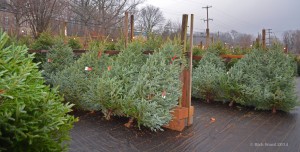If you’re one of the millions who choose to put up a live Christmas tree each year, what are your reasons for selecting the perfect tree? Is it purely the species, like a Fir or Pine? Is it based on the size, shape and fullness? Does the scent (smell) of the tree have anything to do with it? Or, is it merely a matter of economics-who is it selling them for the cheapest price? Whatever your criteria, picking out that flawless tree can become quite a quest! Even more so, if you prefer to cut your own.
In the days immediately following Thanksgiving, it seems like small herds of fresh cut Christmas trees begin migrating to every corner, vacant lot or large parking area. Signs of all sizes appear at intersections directing you to drive 10 miles out of your way for the “best selection.” Christmas tree farms are a huge agricultural industry, with much of the business conducted in about 6-week season.

Cutting your own tree has become quite a trend in recent years. In our area, there is at least a half dozen Christmas tree farms that go all out for your visit. When you arrive, you’re greeted with a cup of hot chocolate and then guided to a tractor-driven (or horse-drawn) hay wagon that will carry you to a field full of natural, emerald-colored evergreens waiting to be cut. To top it off, you can finish your outing with a quick stop in their Christmas shop to purchase an ornament or wreath to compliment your new tree. It’s truly an all-day experience! However, the “experience” of cutting your own tree certainly has changed over the years.
In 1975, my oldest brother, Jimmy, pioneered a legendary approach for obtaining your own live Christmas tree. It was short-lived, but extremely resourceful and quite entertaining! He recruited (bribed?) my sister Cathy and somehow convinced Pa they could handle the task of acquiring a live tree for the Wood Family Christmas. After trekking through our back woods, my brother declared he had found the perfect tree-it didn’t really matter that it was 40 feet above their heads! You see, his plan was to climb a large Hemlock and cut off the top 8 feet, since the top seemed to be just what we needed in our living room! So, with the skills of Paul Bunyan and handsaw slung over his back, he ascended, branch after branch, until he reached his goal. After a few quick strokes of the saw blade, our new tree came crashing down to the ground, scattering birds and squirrels in every direction and sending my sister diving for cover! Not until they dragged it back to the house and squeezed it through the door, did Jimmy discover it was about 5 feet taller than our living room ceiling. Nothing that a few strokes of the hand saw couldn’t fix! We’ll always remember that Christmas as the year Jimmy re-defined “trimming the tree!”

Today, many large U.S. cities also put up live trees to celebrate the holiday season, including New York City’s famous Rockefeller Center. As a matter of fact, this year’s Big Apple tree came from right here in Pennsylvania, a towering 85-foot Norway spruce from Danville. The White House, too, looked to PA for its honorary tree in 2014. An 18’ Douglas fir, grown at Crystal Springs Farm in Lehighton, has been named the Grand Champion tree and will be displayed in the Blue Room. In the Keystone State, Christmas trees are grown in every County except Philadelphia, and Pennsylvania ranks in the top five states in the U.S. for number of trees grown.
An added benefit of real Christmas trees is the habitat they provide for wildlife. While growing in the fields, many species of birds may use them for nesting sites. After the holidays, they can be recycled by putting them back outside to act as cover for wintering wildlife, or having them chipped into mulch. Of course, all those growing evergreens also help in providing oxygen for people to breathe. Whatever your vision of the perfect tree might be, don’t wait too long, before you know it, all those “premium cut trees” will be gone! Good Luck with your search!


